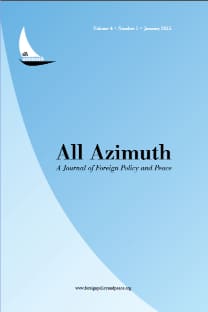Reputation Building as a Strategy for Terror Group Survival
Reputation Building as a Strategy for Terror Group Survival
___
- Abrahms, Max. Rules for Rebels: The Science of Victory in Militant History. Oxford University Press, 2018.
- Akcinaroglu, Seden, and Efe Tokdemir. “To Instill Fear or Love: Terrorist Groups and the Strategy of Building Reputation.” Conflict Management and Peace Science 35, no. 4 (2018): 355–77.
- Berman, Eli. “Hamas, Taliban and the Jewish Underground: An Economist’s View of Radical Religious Militias.” Working Paper 10004, National Bureau of Economic Research, 2004.
- Berman, Eli, and David D. Laitin. “Religion, Terrorism and Public Goods: Testing the Club Model.” Journal of Public Economics 92, no. 10-11 (2008): 1942–967.
- Blomberg, S. Brock, Khusrav Gaibulloev, and Todd Sandler. “Terrorist Group Survival: Ideology, Tactics, and Base of Operations.” Public Choice 149, no. 3/4 (2011): 441–63.
- Blomberg, S. Brock, Rozlyn C. Engel, and Reid Sawyer. “On the Duration and Sustainability of Transnational Terrorist Organisations.” Journal of Conflict Resolution 54, no. 2 (2010): 303–30.
- Box-Steffensmeier, Janet M., and Bradford S. Jones. Event History Modeling: A Guide for Social Scientists. Cambridge University Press, 2004.
- Byman, Daniel. Deadly Connections: States that Sponsor Terrorism. Cambridge University Press, 2005.
- Chandrakanthan, A. J. V. “Eelam Tamil Nationalism: An Inside View.” In Sri Lankan Tamil Nationalism: Its Origins and Development in the Nineteenth and Twentieth Centuries, edited by A. Jayaratnam Wilson, 157–75. London: Hurst and Company, 2000.
- Connell, Dan. “Inside the EPLF: The Origins of the ‘People’s Party’ & its Role in the Liberation of Eritrea.” Review of African Political Economy 28, no. 89 (2001): 345–64.
- Conrad, Justin. “Interstate Rivalry and Terrorism. An Un-probed Link.” Journal of Conflict Resolution 55, no. 4 (2011): 529–55.
- Cronin, Audrey Kurth. How Terrorism Ends: Understanding the Decline and Demise of Terrorist Campaigns. Princeton and Oxford: Princeton University Press, 2009.
- Daxecker, Ursula E., and Michael L. Hess. “Repression Hurts Coercive Government Responses and the Demise of Terrorist Campaigns.” British Journal of Political Science 43, no. 3 (2013): 559–77.
- Denov, Myrian. Child Soldiers: Sierra Leone’s Revolutionary United Front. Cambridge: Cambridge University Press, 2010.
- Dugan, Lauran, and Joseph Young. “Allow Extremist Participation in the Policymaking Process.” In Contemporary Issues in Criminal Justice Policy, edited by Natasha Frost, Joshua Freilich, and Todd R. Clear, 159–69. Wadsworth, 2010.
- Eck, Krsitine. “Coercion in Rebel Recruitment.”Security Studies 23 (2014): 364–98.
- Ehrlich, Paul R., and Jiangou Liu. “Some Roots of Terrorism.” Population and Environment 24, no. 20 (2002): 183–92.
- Enders, Walter, and Todd Sandler. “Transnational Tterrorism in the Post–Cold War Era.” International Studies Quarterly 43, no. 1 (1999): 145–67.
- Eyerman, Joe. “Terrorism and Democratic States: Soft Targets or Accessible Systems.” International Interactions 24 (1998): 151–70.
- Farrall, Leah. “How al Qaeda Works: What the Organization’s Subsidiaries Say about Its Strength.” Foreign Affairs 90 (2011): 128.
- Fearon, James D., and Laitin, David D. “Ethnicity, Insurgency, and Civil War.” American Political Science Review 97, no. 1 (2003): 75–90.
- Fine, Jason, and Robert Gray. “A Proportional Hazards Model for the Subdistribution of a Competing Risk.” Journal of the American Statistical Association 94 (1999): 496–509.
- Fortna, Page. “Do Terrorists Win? Rebels’ Use of Terrorism and Civil War Outcomes: 1989-2009.” International Organization 69, no. 3 (2015): 519–56.
- Gates, Scott. “Recruitment and Allegiance: Microfoundations of Rebellion.” Journal of Conflict Resolution 46, no. 1 (2002): 111–30.
- Grambsch, Patricia M., and Terry M. Therneau. “Proportional Hazards Tests and Diagnostics Based on Weighted Residuals.” Biometrika 81, no. 3 (2002): 515–26.
- Jones, Seth G., and Martin C. Libicki. How Terrorist Groups End: Lessons for Countering Al Qa’ida. Rand Corporation, 2008.
- Klein, John P. “Competing Risks.” Wiley Interdisciplinary Reviews: Computational Statistics 2, no. 3 (2010): 333– 39.
- Kruglanski, Arie W., Keren Sharvit, and Shira Fishman. “Workings of the Terrorist Mind Its Individual, Group and Organizational Psychologies.” In Intergroup Conflicts and Their Resolution: A Social Psychological Perspective, edited by Daniel Bar-Tal, 195–217. New York: Psychology Press, 2010.
- McLauchlin, Theodore, and Wendy Pearlman. “Out-Group Conflict, In-Group Unity? Exploring the Effect of Repression on Intra-Movement Cooperation.” Journal of Conflict Resolution 56, no. 1 (2012): 41–66.
- Nemeth, Stephen. “The Effect of Competition on Terrorist Group Operations.” Journal of Conflict Resolution 58, no. 2 (2014): 336–62.
- Paul, Christopher. “How do Terrorists Generate Maintain Support?” In Social Science for Counterrorism: Putting the Pieces Together, edited by Paul K. Davis and Kim Craigin, 113–50. RAND National Defense Research Institute, 2009. Phillips, Brian J. “Terrorist Group Cooperation and Longevity.” International Studies Quarterly 58, no. 2 (2014): 336–47.
- Piazza, James A. “Poverty, Minority Economic Discrimination, and Domestic Terrorism.” Journal of Peace Research 48, no. 3 (2011): 339–53.
- San-Akca, Belgin. States in Disguise: Causes of State Support for Rebel Groups. New York: Oxford University Press, 2016. Schoenfeld, David. “Partial Residuals for the Proportional Hazard Regression Model.” Biometrica 69, no. 1 (1982):239–41.
- Tarrow, Sidney. Power in Movements. Cambridge: Cambridge University Press, 1998.
- Tokdemir, Efe, and Seden Akcinaroglu. “Reputation of Terror Groups Dataset: Measuring Popularity of Terror Groups.” Journal of Peace Research 53, no. 2 (2016): 268–77.
- Tse-tung, Mao. On Guerrilla Warfare. Translated by Samuel B. Griffith II. Chicago, IL: University of Illinois Press, 2000 [1937].
- Young, Joseph K., and Laura Dugan. “Survival of the Fittest: Why Terrorist Groups Endure.” Perspectives on Terrorism 8, no. 2 (2014): 1–23.
- Weinberg, Leonard. The End of Terrorism? New York, NY: Routledge, 2012.
- Weinstein, Jeremy. Inside Rebellion: The Politics of Insurgent Violence. New York, NY: Cambridge University Press, 2007.
- ISSN: 2146-7757
- Yayın Aralığı: 2
- Başlangıç: 2012
- Yayıncı: Dış Politika ve Barış Araştırmaları Merkezi, İhsan Doğramacı Barış Vakfı
Hedging as a Survival Strategy for Small States: The Case of Kuwait
Mehmet RAKİPOĞLU, İsmail Numan TELCİ
Reputation Building as a Strategy for Terror Group Survival
Tianxia (All-Under-Heaven): An Alternative System or a Rose by another Name?
The Interactions of International Relations: Racism, Colonialism, Producer-Centred Research
